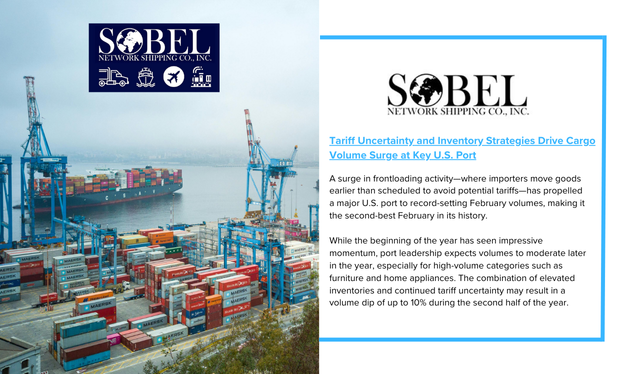A surge in frontloading activity—where importers move goods earlier than scheduled to avoid potential tariffs—has propelled a major U.S. port to record-setting February volumes, making it the second-best February in its history.
While the beginning of the year has seen impressive momentum, port leadership expects volumes to moderate later in the year, especially for high-volume categories such as furniture and home appliances. The combination of elevated inventories and continued tariff uncertainty may result in a volume dip of up to 10% during the second half of the year.
Until then, steady volume growth is anticipated through the first and second quarters. Many importers are accelerating shipments to avoid potential disruptions stemming from global logistics challenges, including labor concerns, geopolitical tensions affecting key shipping routes, and environmental issues at major canals.
Recent changes in trade policy have reintroduced significant tariffs on imports from certain countries, while others remain temporarily exempt. As a result, import patterns have shifted. Cargo volumes from some Asian countries, particularly one major supplier, have declined from previous highs as businesses explore diversified sourcing strategies across the region.
Despite this, many importers are still actively negotiating with manufacturers in these traditional sourcing hubs, aiming to balance cost, speed, and reliability. Past experiences show that ahead of major tariff implementations, ports often see a spike in activity followed by notable slowdowns.
To manage these fluctuations, port authorities continue to leverage digital cargo visibility tools that allow them to forecast container arrivals up to 40 days in advance, providing critical flexibility in operations and planning.
February Port Performance
In February, the port processed 801,398 twenty-foot equivalent units (TEUs), marking a 2.5% year-over-year increase and outperforming the five-year February average by more than 15.5%.
Imported goods led the growth, with loaded imports reaching 413,236 TEUs—17% above the port’s five-year average. However, export activity fell 18% year over year to 109,156 TEUs, representing the third consecutive month of export declines following two years of growth.
Port stakeholders, especially in agriculture and manufacturing, are closely monitoring the evolving trade landscape as new retaliatory tariffs are introduced globally, affecting outbound U.S. shipments such as food and textile goods.
While the long-term impact of current trade tensions remains uncertain, logistics professionals are watching closely, continuing to adapt their strategies to minimize risk and maintain supply chain continuity.


